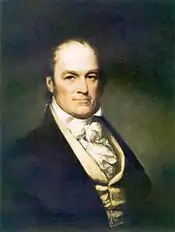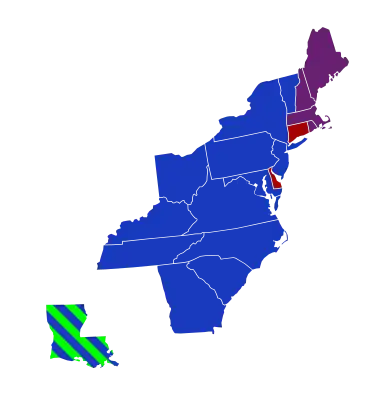12th United States Congress
The 12th United States Congress was a meeting of the legislative branch of the United States federal government, consisting of the United States Senate and the United States House of Representatives. It met in Washington, D.C. from March 4, 1811, to March 4, 1813, during the third and fourth years of James Madison's presidency. The apportionment of seats in the House of Representatives was based on the 1800 United States census. Both chambers had a Democratic-Republican majority.
| 12th United States Congress | |
|---|---|
11th ← → 13th | |
 United States Capitol (1800) | |
March 4, 1811 – March 4, 1813 | |
| Members | 36 senators 143 representatives 5 non-voting delegates |
| Senate majority | Democratic-Republican |
| Senate President | George Clinton (DR)[lower-alpha 1] (until April 20, 1812) Vacant (from April 20, 1812) |
| House majority | Democratic-Republican |
| House Speaker | Henry Clay (DR) |
| Sessions | |
| 1st: November 4, 1811 – July 6, 1812 2nd: November 2, 1812 – March 3, 1813 | |
Major events
- November 6, 1811: Battle of Tippecanoe: William Henry Harrison defeated Tecumseh's forces
- December 16, 1811: New Madrid earthquake
- April 4, 1812: President Madison enacted a 90-day embargo on trade with the United Kingdom
- April 20, 1812: Vice President George Clinton died
- June 18, 1812: War of 1812: United States declared war on Great Britain
- August 16, 1812: War of 1812: Detroit surrendered to the British.
- October 13, 1812: War of 1812: the Battle of Queenston Heights
- November 5, 1812: Elections of 1812:
Major legislation
States admitted and territories organized
- April 30, 1812: Louisiana was admitted as a state into the Union. It was formerly known as the Territory of Orleans
- June 4, 1812: Missouri Territory was organized. It was formerly known as Louisiana Territory

George Clinton

William H. Crawford

Henry Clay
Party summary
The count below identifies party affiliations at the beginning of the first session of this congress. Changes resulting from subsequent replacements are shown below in the "Changes in membership" section.
Senate
During this congress, two new Senate seats were added for the new state of Louisiana.
| Party (shading shows control) |
Total | Vacant | ||
|---|---|---|---|---|
| Democratic- Republican (DR) |
Federalist (F) | |||
| End of previous congress | 26 | 8 | 34 | 0 |
| Begin | 26 | 7 | 33 | 1 |
| End | 29 | 36 | 0 | |
| Final voting share | 80.6% | 19.4% | ||
| Beginning of next congress | 27 | 6 | 33 | 3 |
House of Representatives
During this congress, one new House seat was added for the new state of Louisiana.
| Party (shading shows control) |
Total | Vacant | ||
|---|---|---|---|---|
| Democratic- Republican (DR) |
Federalist (F) | |||
| End of previous congress | 95 | 46 | 141 | 1 |
| Begin | 106 | 36 | 142 | 0 |
| End | 1 | |||
| Final voting share | 74.6% | 25.4% | ||
| Beginning of next congress | 108 | 68 | 176 | 6 |
Leadership
Senate
- President: George Clinton (DR), until April 20, 1812; vacant thereafter.
- President pro tempore: William H. Crawford (DR)
House of Representatives
Speaker of the United States House of Representatives Henry Clay Democratic-Republican
Members
This list is arranged by chamber, then by state. Senators are listed by class, and representatives are listed by district.
Senate
Senators were elected by the state legislatures every two years, with one-third beginning new six-year terms with each Congress. Preceding the names in the list below are Senate class numbers, which indicate the cycle of their election. In this Congress, Class 1 meant their term began in the last Congress, requiring re-election in 1814; Class 2 meant their term began with this Congress, requiring re-election in 1816; and Class 3 meant their term ended with this Congress, requiring re-election in 1812
Connecticut
Delaware
Georgia
Kentucky
Louisiana
Maryland
Massachusetts
New Hampshire
New Jersey
|
New York
North Carolina
Ohio
Pennsylvania
Rhode Island
South Carolina
Tennessee
Vermont
Virginia
|
 Senators' party membership by state at the opening of the 12th Congress in March 1811. Louisiana's senators were not seated until September 3, 1812, and one of them was of unknown party affiliation.
2 Democratic-Republicans
1 Democratic-Republican and 1 Federalist
2 Federalists
|
House of Representatives
The names of members of the House of Representatives are preceded by their district numbers.
Changes in membership
The count below reflects changes from the beginning of the first session of this Congress.
Senate
- Replacements: 1
- Democratic-Republicans: no net change
- Federalists: no net change
- Deaths: 0
- Resignations: 4
- Interim appointments: 1
- Seats of newly admitted states: 2
- Vacancies:1
- Total seats with changes: 6
| State (class) |
Vacated by | Reason for change | Successor | Date of successor's formal installation[lower-alpha 2] |
|---|---|---|---|---|
| Massachusetts (2) |
Vacant | Legislature elected late. Successor elected June 29, 1811. |
Joseph B. Varnum (DR) | June 29, 1811 |
| Rhode Island (1) |
Christopher G. Champlin (F) | Resigned October 2, 1811 Successor elected October 28, 1811. |
William Hunter (F) | October 28, 1811 |
| Tennessee (2) |
Jenkin Whiteside (DR) | Resigned October 8, 1811. Successor elected October 8, 1811. |
George W. Campbell (DR) | October 8, 1811 |
| Louisiana (3) |
New seat | Louisiana was admitted to the Union on April 30, 1812. Inaugural Senator elected September 3, 1812, for the term ending March 4, 1813. |
Allan B. Magruder (DR) | September 3, 1812 |
| Louisiana (2) |
New seat | Louisiana was admitted to the Union on April 30, 1812. Inaugural Senator elected September 3, 1812, for the term ending March 4, 1817. |
Jean Noel Destréhan (DR) | September 3, 1812 |
| Jean N. Destréhan (DR) | Resigned October 1, 1812, without having qualified. Successor appointed October 8, 1812, to continue the term ending March 4, 1817. |
Thomas Posey (DR) | October 8, 1812 | |
| Thomas Posey (DR) | Appointee lost election to finish the term. Successor elected February 4, 1813. |
James Brown (DR) | February 5, 1813 |
House of Representatives
- Replacements: 3
- Democratic-Republicans: no net change
- Federalists: no net change
- Deaths: 2
- Resignations: 5
- Contested election: 1
- Seats of newly admitted states: 1
- Vacancies: 1
- Total seats with changes: 10
| District | Vacated by | Reason for change | Successor | Date of successor's formal installation[lower-alpha 2] |
|---|---|---|---|---|
| Maryland 6th |
John Montgomery (DR) | Resigned April 29, 1811, to become attorney General of Maryland | Stevenson Archer (DR) | Seated October 26, 1811 |
| Massachusetts 4th |
Joseph B. Varnum (DR) | Resigned June 29, 1811, to become U.S. Senator | William M. Richardson (DR) | Seated November 4, 1811 |
| Virginia 8th |
John Hungerford (DR) | Lost contested election November 29, 1811 | John Taliaferro (DR) | Seated November 29, 1811 |
| Massachusetts 17th |
Barzillai Gannett (DR) | Resigned sometime in 1812 before April 6 ([data missing]) | Francis Carr (DR) | Seated April 6, 1812 |
| North Carolina 3rd |
Thomas Blount (DR) | Died February 7, 1812 | William Kennedy (DR) | Seated January 30, 1813 |
| Orleans Territory | Julien de Lallande Poydras had resigned in the previous Congress, and the seat remained vacant until the territory became the state of Louisiana on April 30, 1812 | Thomas B. Robertson (DR) | Seated April 30, 1812 | |
| Louisiana at-large | ||||
| New York 6th |
Robert Le Roy Livingston (F) | Resigned May 6, 1812 | Thomas P. Grosvenor (F) | Seated January 29, 1813 |
| Georgia at-large |
Howell Cobb (DR) | Resigned sometime before October 1812 ([data missing]) | William Barnett (DR) | Seated October 5, 1812 |
| Missouri Territory | Territory delegate seat established | Edward Hempstead | Seated November 9, 1812 | |
| Illinois Territory | Territory delegate seat established | Shadrach Bond | Seated December 3, 1812 | |
| Pennsylvania 9th |
John Smilie (DR) | Died December 30, 1812 | Vacant | Not filled until next Congress |
Committees
Lists of committees and their party leaders.
Senate
- Audit and Control the Contingent Expenses of the Senate (Chairman: Michael Leib)
- Engrossed Bills (Chairman: Nicholas Gilman)
- National University
- Whole
House of Representatives
- Accounts (Chairman: Charles Turner Jr.)
- Apportionment of Representatives (Select)
- Bankruptcy (Select)
- Claims (Chairman: Burwell Bassett then Thomas Gholson Jr.)
- Commerce and Manufactures (Chairman: Thomas Newton Jr.)
- District of Columbia (Chairman: Joseph Lewis Jr.)
- Elections (Chairman: William Findley)
- Post Office and Post Roads (Chairman: John Rhea)
- Public Lands (Chairman: Jeremiah Morrow)
- Revisal and Unfinished Business (Chairman: Adam Seybert then Burwell Bassett)
- Rules (Select)
- Standards of Official Conduct
- Ways and Means (Chairman: Ezekiel Bacon then Langdon Cheves)
- Whole
Joint committees
- Enrolled Bills (Chairman: [data missing])
- The Library (Chairman: N/A)
Employees
Legislative branch agency directors
- Architect of the Capitol: Benjamin Latrobe, until July 1, 1811; vacant thereafter
- Librarian of Congress: Patrick Magruder
Senate
- Chaplain: Walter D. Addison (Presbyterian), until November 13, 1811
- John Brackenridge (Presbyterian), from November 13, 1811
- Secretary: Samuel A. Otis
- Sergeant at Arms: James Mathers, died
- Mountjoy Bayly, elected November 6, 1811
House of Representatives
- Chaplain: Jesse Lee (Methodist), until November 13, 1811
- Nicholas Snethen (Methodist), elected November 13, 1811
- Jesse Lee (Methodist), elected November 2, 1812
- Clerk: Patrick Magruder
- Doorkeeper: Thomas Claxton
- Reading Clerks: [data missing]
- Sergeant at Arms: Thomas Dunn
See also
- 1810 United States elections (elections leading to this Congress)
- United States elections, 1812 (elections during this Congress, leading to the next Congress)
Notes
- U.S. Vice President George Clinton's term as President of the Senate ended on April 20, 1812 when he died in office, President pro tempore William H. Crawford acted his duties as the President of the Senate.
- When seated or oath administered, not necessarily when service began.
References
- Martis, Kenneth C. (1989). The Historical Atlas of Political Parties in the United States Congress. New York: Macmillan Publishing Company.
- Martis, Kenneth C. (1982). The Historical Atlas of United States Congressional Districts. New York: Macmillan Publishing Company.